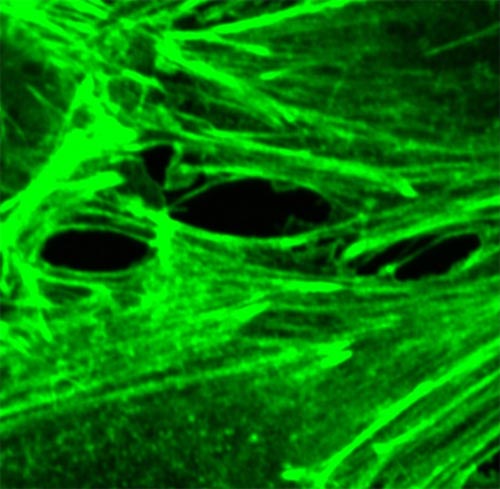

This image, taken by confocal microscopy, shows a blood vessel. The protein actin, which helps make up the skeleton of a cell, is labeled in green. Thrombin, a pro-inflammatory mediator, causes gaps between blood vessel barrier cells. When the immune system is over-activated, as occurs in sepsis, blood vessels can become leaky and major organs can’t get the oxygen and nutrients they require to sustain life.
Credit: UC San Diego Health Sciences
New insights for sepsis therapeutics.
Lab studies reveal protein HSP27’s role in blood vessel leakage, opening the possibility that therapeutically dialing its activity up or down might stabilize patients with sepsis.
Sepsis occurs when the body works so hard to fight an infection that the over-activated immune system harms a patient’s own tissues as collateral damage. As a result, blood vessels can become leaky and major organs can’t get the oxygen and nutrients they require to sustain life. Sepsis is a major reason that patients, including many with COVID-19, end up in the intensive care unit. The condition is notoriously difficult to treat, and there are no drugs that help stabilize the cell barrier that lines blood vessels.
University of California San Diego School of Medicine researchers are working to better understand how the body controls blood vessel permeability, and how they might intervene to restore blood vessel integrity during sepsis, trauma or other conditions.
The team recently discovered that a protein called HSP27 plays a role in regulating blood vessel leakage. To help breakdown or buildup blood vessel barrier, cells add and remove chemical tags on HSP27.
The study, publishing August 31, 2021 in Science Signaling, provides new potential targets for the development of drugs that shore up blood vessel barriers, preventing fluid loss.
“This new information will help us home in on the root cause of leaky blood vessels, rather than taking a broad strokes approach that may have many off-target effects,” said senior author JoAnn Trejo, PhD, professor of pharmacology and assistant vice chancellor of the Office of Health Sciences Faculty Affairs at UC San Diego School of Medicine.
Blood vessel barriers need to be dynamic — permeable enough to allow immune cells to squeeze out to reach the site of an infection, for example, but not so leaky that the situation becomes life-threatening. According to Trejo, HSP27 binds to proteins that help form the cell’s “skeleton.” She and colleagues suspect that’s why HSP27 can affect blood vessel permeability — by fortifying the skeleton of cells that maintain the barrier.
Trejo has long studied G-protein-coupled receptors (GPCRs), proteins that are embedded in cell membranes throughout the body, where they act as signal transducers, allowing cells to respond to their external environments. GPCRs play a crucial role in most biological functions. Approximately one-third of all therapeutic drugs on the market work because they influence GPCR signals.
In their latest study, the team found that during inflammation, GPCRs tell enzymes called kinases to add chemical (phosphate) tags to HSP27. The tags perturb HSP27’s structure in a way that disrupts blood vessel barriers. When HSP27 reassembles, the barriers recover. The researchers validated their lab studies in mice, where they found that inhibiting HSP27 increases blood vessel leakage.
One challenge in targeting GPCRs to treat a disease is the fact that most act as master regulators, influencing several different cell functions. Inhibiting one GPCR may have many unintended consequences. By focusing further downstream — aiming not at the master GPCR but at individual targets upon which it acts, such as HSP27 — Trejo’s team is hoping to enable the development of blood vessel barrier-stabilizing drugs that are more precise and have fewer negative side effects.
“It’s become apparent that you can develop different molecules that can bind to receptor and ‘bias’ them — make them signal in a very specific way to some pathways but not others,” Trejo said. “It’s what we call biased agonism, and it’s a huge advantage for drug development. It means we can develop not just an on/off switch, but a drug that can switch a receptor ‘off’ or eight different types of ‘on.’ We want to be able to tweak which pathways are on and not touch others.”
The team plans to explore additional cell signaling pathways that helps blood vessels build resistance to injury and inflammation.
Co-authors include: Cara C. Rada, Hilda Mejia-Pena, Isabel Canto Cordova, Joshua Olson, Jacob M. Wozniak, David J. Gonzalez, Victor Nizet, UC San Diego; and Neil J. Grimsey, University of Georgia.
Journal: Science Signaling
DOI: 10.1126/scisignal.abc1044
Article Publication Date: 31-Aug-2021
Media Contact
Heather Buschman
hbuschman@ucsd.edu












